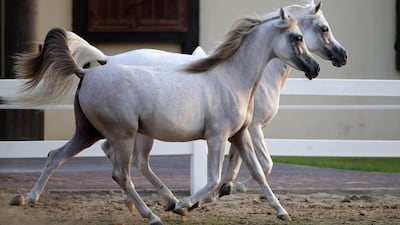With their curved faces, wide-set eyes, long necks and high tails, Arabian horses have a beauty that few other creatures can match. There are not many things more impressive than one of these majestic animals running at high speed.
There is, of course, a less charmed side to their existence, and Arabian horses can fall victim to many illnesses and injuries. They are susceptible to, for example, intestinal stones called equine enteroliths, and are also prone to certain skin conditions.
Probably no one knows more about the hundreds of illnesses Arabian horses and other equines face than Dr Sameeh Abutarbush, head of the Veterinary Medicine Department at UAE University in Al Ain.
Dr Abutarbush, 41, has used his two decades of expertise in equine veterinary medicine to write what is thought to be the most comprehensive atlas of horse diseases yet produced. The Atlas of Equine Diseases details hundreds of conditions and includes more than 2,650 photographs, many of them images of illnesses, taken by Dr Abutarbush, who has published four more books.
“I love animals in general but horses have a special character – they’re beautiful, they’re smart. That’s why I wanted to be a horse specialist,” he says.
Dr Abutarbush has treated thousands of horses during his career, which included a four-year spell working in an equine hospital. He has also carried out much research into horses, publishing more than 56 scientific papers and, in western Canada, he discovered the presence of a disease called West Nile Virus.
In addition, he described a new way to diagnose a deadly type of colic in the horse using ultrasonography, which employs ultrasound to produce images of internal body structures. Other veterinarians often send him photographs and videos for a second opinion.
There are some conditions that tend to afflict horses today more often than in the past. Particular issues include colic – belly ache – and lameness.
“The main reason why horses suffer more from colic is because we humans have changed their feeding style and feeding habits,” says Dr Abutarbush, who is from Jordan and who worked in the United States, Canada and his home country before moving to the Emirates to set up UAEU’s veterinary medicine department.
“Horses, when you look before domestication, they were out in the field, they were grazing all the time.
“The horses that do have access to food all the time and they have enough area to exercise, they don’t have much colic compared to most of the horse population we deal with in stables and arenas.
“When we have them in stables, they have free access to water but not food most of the time. And we give them grain, which makes them susceptible.”
Also, he said spending time in stables means the horses are not exercising constantly, another factor making colic more likely.
When they are exercised, the physical strains on them can be greater than is the case under natural conditions.
“It depends on the breed and the sport the horse is used for. Most of these sports, they do put [the horse under] lots of pressure,” said Dr Abutarbush.
While modern conditions have made horses more likely to fall victim to some illnesses or injuries, other factors protect them, particularly when it comes to infectious diseases.
With people travelling more, human diseases can spread much more quickly than before. Dr Stephen Ostroff, deputy commissioner for foods and veterinary medicine at the US Food and Drug Administration, noted in a briefing document that, for example, HIV, the virus that causes Aids, “spread to every corner of the world less than a decade after it was recognised in the early 1980s”.
He described Middle East Respiratory Syndrome (Mers), first identified four years ago, as one of a number of cases that “demonstrate[s] how crucial travel has become to the spread of emerging diseases”. Within just two years of its discovery in 2012, cases were recorded in the Middle East, North Africa, Asia, Europe and North America. More recently, the spread of the Zika virus to such places as Singapore has hit the headlines.
Similarly, scientists have expressed concern about the effect that global trade may be having on the movement of plant diseases.
Yet while horse racing can likewise be a global business, Dr Abutarbush says that diseases now tend to be better controlled than in the past. Regulations are tougher and animals have to be certified as disease-free before they can travel.
“It has to have a certificate that it’s been vaccinated with X and Y, otherwise the horse cannot travel,” he says.
“And some countries, even with that, when they arrive, they’re put in quarantine until they do their own examination and lab testing to make sure they’re free of certain diseases.
“I think the level [of travel of horses] is about the same, but the spread of the diseases or possibility of spread is lower because the international regulations and rules are more restrictive.”
Improved technology, such as techniques involving molecular biology to diagnose disease, are also helping to curtail illnesses travelling with the horses.
Although he has treated thousands of horses, Dr Abutarbush has been attacked by one only “very few times”.
“Horses will not attack you because they are mean, it’s because they are afraid of you, that’s why they kick and they bite,” he says.
“If you read their behaviour and you know how to approach them in a way that makes them not afraid of you, they will not hurt you.”
Although they are not particularly liable to attack people, Arabian horses can, says Dr Abutarbush, sometimes be difficult to deal with.
“Their character is different; they have a very strong character … most of the time you cannot bully them. They are stubborn, they do what they want,” he said.
“But what I like most about them is their shape. They’re absolutely fascinating. Their face is so beautiful.”
newsdesk@thenational.ae


